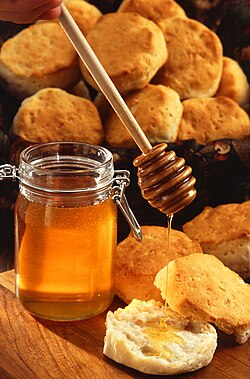
Back Heuning Afrikaans Honig ALS ማር Amharic Miel AN Hunig ANG عسل Arabic ܕܒܫܐ ARC عسل ARZ Miel AST Misk'i Aymara
Honey is a sweet and viscous substance made by several species of bees, the best-known of which are honey bees.[1][2] Honey is made and stored to nourish bee colonies. Bees produce honey by gathering and then refining the sugary secretions of plants (primarily floral nectar) or the secretions of other insects, like the honeydew of aphids. This refinement takes place both within individual bees, through regurgitation and enzymatic activity, and during storage in the hive, through water evaporation that concentrates the honey's sugars until it is thick and viscous.
Honey bees stockpile honey in the hive. Within the hive is a structure made from wax called honeycomb. The honeycomb is made up of hundreds or thousands of hexagonal cells, into which the bees regurgitate honey for storage. Other honey-producing species of bee store the substance in different structures, such as the pots made of wax and resin used by the stingless bee.[1][2][3]
Honey for human consumption is collected from wild bee colonies, or from the hives of domesticated bees. The honey produced by honey bees is the most familiar to humans, thanks to its worldwide commercial production and availability.[4] The husbandry of bees is known as beekeeping or apiculture, with the cultivation of stingless bees usually referred to as meliponiculture.
Honey is sweet because of its high concentrations of the monosaccharides fructose and glucose. It has about the same relative sweetness as sucrose (table sugar).[5][6] One standard tablespoon (15 mL) of honey provides around 190 kilojoules (46 kilocalories) of food energy.[7] It has attractive chemical properties for baking and a distinctive flavor when used as a sweetener.[5] Most microorganisms cannot grow in honey and sealed honey therefore does not spoil. Samples of honey discovered in archaeological contexts have proven edible even after millennia.[8][9]

Honey use and production has a long and varied history, with its beginnings in prehistoric times. Several cave paintings in Cuevas de la Araña in Spain depict humans foraging for honey at least 8,000 years ago.[10][11] While Apis mellifera is an Old World insect, large-scale meliponiculture of New World stingless bees has been practiced by Mayans since pre-Columbian times.[2][12]
- ^ a b Crane, Eva (1990). "Honey from honeybees and other insects". Ethology Ecology & Evolution. 3 (sup1): 100–105. doi:10.1080/03949370.1991.10721919. ISSN 0394-9370.
- ^ a b c Grüter, Christoph (2020). Stingless Bees: Their Behaviour, Ecology and Evolution. Fascinating Life Sciences. Springer New York. doi:10.1007/978-3-030-60090-7. ISBN 978-3-030-60089-1. S2CID 227250633. Archived from the original on 20 April 2023. Retrieved 27 May 2021.
- ^
- Crane, Eva; Walker, P.; Day, R. (1984). Directory of important world honey sources. International Bee Research Association. ISBN 978-0-86098-141-1. Archived from the original on 13 July 2023. Retrieved 13 July 2023.
- Grüter, Christoph (2020). Stingless Bees: Their Behaviour, Ecology and Evolution. Fascinating Life Sciences. Springer New York. doi:10.1007/978-3-030-60090-7. ISBN 978-3-030-60089-1. S2CID 227250633. Archived from the original on 20 April 2023. Retrieved 27 May 2021.
- ^ Crane, Ethel Eva (1999). The World History of Beekeeping and Honey Hunting. Routledge. ISBN 978-1-136-74670-3.
- ^ a b National Honey Board. "Carbohydrates and the Sweetness of Honey" Archived 1 July 2011 at the Wayback Machine. Last accessed 1 June 2012.
- ^ Oregon State University "What is the relative sweetness of different sugars and sugar substitutes?". Retrieved 1 June 2012.
- ^ Cite error: The named reference
Nutrient Datawas invoked but never defined (see the help page). - ^ Geiling, Natasha (22 August 2013). "The Science Behind Honey's Eternal Shelf Life". Smithsonian. Archived from the original on 10 June 2023. Retrieved 9 September 2019.
- ^ Prescott, Lansing; Harley, John P.; Klein, Donald A. (1999). Microbiology. Boston: WCB/McGraw-Hill. ISBN 978-0-697-35439-6.
- ^ Cite error: The named reference
huntwas invoked but never defined (see the help page). - ^ Cite error: The named reference
Crane83was invoked but never defined (see the help page). - ^ Quezada-Euán, José Javier G. (2018). Stingless Bees of Mexico. Springer New York. doi:10.1007/978-3-319-77785-6. ISBN 978-3-030-08539-1. S2CID 51912114. Archived from the original on 13 July 2024. Retrieved 27 May 2021.
